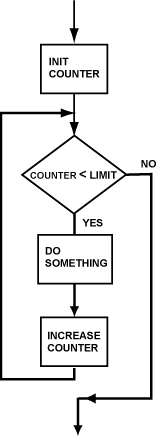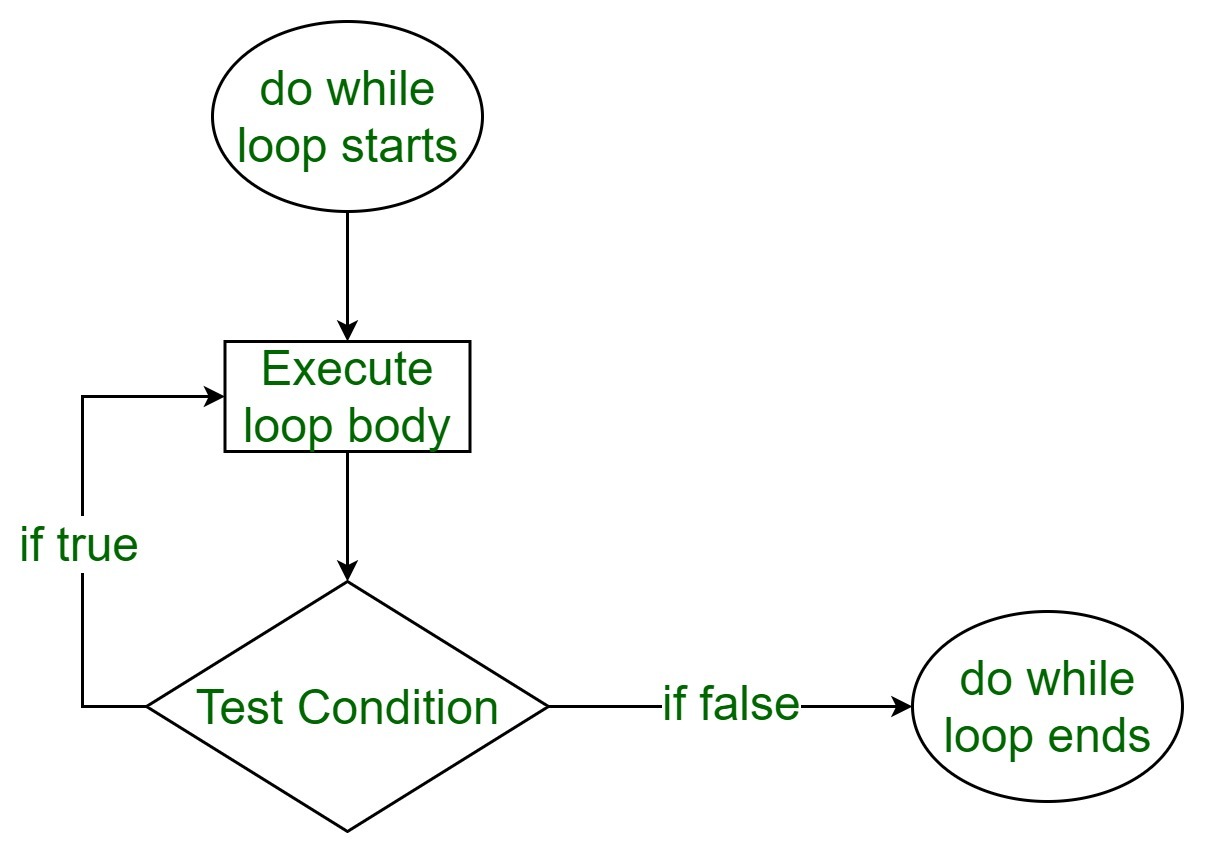Laboratory 3: Loops, Looops, Loooooops
# Preamble script block to identify host, user, and kernel
import sys
! hostname
! whoami
print(sys.executable)
print(sys.version)
print(sys.version_info)

Program flow control (Loops)
- Controlled repetition
- Structured FOR Loop
- Structured WHILE Loop
Count controlled repetition

Count-controlled repetition is also called definite repetition because the number of repetitions is known before the loop begins executing. When we do not know in advance the number of times we want to execute a statement, we cannot use count-controlled repetition. In such an instance, we would use sentinel-controlled repetition.
A count-controlled repetition will exit after running a certain number of times. The count is kept in a variable called an index or counter. When the index reaches a certain value (the loop bound) the loop will end.
Count-controlled repetition requires
- control variable (or loop counter)
- initial value of the control variable
- increment (or decrement) by which the control variable is modified each iteration through the loop
- condition that tests for the final value of the control variable
We can use both for and while loops, for count controlled repetition, but the for loop in combination with the range() function is more common.
Structured FOR loop¶
We have seen the for loop already, but we will formally introduce it here. The for loop executes a block of code repeatedly until the condition in the for statement is no longer true.
Looping through an iterable¶
An iterable is anything that can be looped over - typically a list, string, or tuple. The syntax for looping through an iterable is illustrated by an example.
First a generic syntax
for a in iterable:
print(a)
Notice the colon : and the indentation.
Now a specific example:
Example: A Loop to Begin With!¶
Make a list with "Walter", "Jesse", "Gus, "Hank". Then, write a loop that prints all the elements of your lisk.
# set a list
BB = ["Walter","Jesse","Gus","Hank"]
# loop thru the list
for AllStrings in BB:
print(AllStrings)
The range() function to create an iterable¶
The range(begin,end,increment) function will create an iterable starting at a value of begin, in steps defined by increment (begin += increment), ending at end.
So a generic syntax becomes
for a in range(begin,end,increment):
print(a)
The example that follows is count-controlled repetition (increment skip if greater)
# set a list
BB = ["Walter","Jesse","Gus","Hank"]
# loop thru the list
for i in range(0,4,1): # Change the numbers, what happens?
print(BB[i])
# For loop with range
for x in range(1,10,2): # a sequence from 2 to 5 with steps of 1
print(x)
Sentinel-controlled repetition

When loop control is based on the value of what we are processing, sentinel-controlled repetition is used. Sentinel-controlled repetition is also called indefinite repetition because it is not known in advance how many times the loop will be executed.

It is a repetition procedure for solving a problem by using a sentinel value (also called a signal value, a dummy value or a flag value) to indicate "end of process". The sentinel value itself need not be a part of the processed data.
One common example of using sentinel-controlled repetition is when we are processing data from a file and we do not know in advance when we would reach the end of the file.
We can use both for and while loops, for Sentinel controlled repetition, but the while loop is more common.
Structured WHILE loop¶
The while loop repeats a block of instructions inside the loop while a condition remainsvtrue.
First a generic syntax
while condition is true:
execute a
execute b
....
Notice our friend, the colon : and the indentation again.
# set a counter
counter = 5
# while loop
while counter > 0:
print("Counter = ",counter)
counter = counter -1
The while loop structure just depicted is a "decrement, skip if equal" in lower level languages. The next structure, also a while loop is an "increment, skip if greater" structure.
# set a counter
counter = 0
# while loop
while counter <= 5: # change this line to: while counter <= 5: what happens?
print ("Counter = ",counter)
counter = counter +1 # change this line to: counter +=1 what happens?
Nested Repetition | Loops within Loops

Round like a circle in a spiral, like a wheel within a wheel
Never ending or beginning on an ever spinning reel
Like a snowball down a mountain, or a carnival balloon
Like a carousel that's turning running rings around the moon
Like a clock whose hands are sweeping past the minutes of its face
And the world is like an apple whirling silently in space
Like the circles that you find in the windmills of your mind!
Windmills of Your Mind lyrics © Sony/ATV Music Publishing LLC, BMG Rights Management
Songwriters: Marilyn Bergman / Michel Legrand / Alan Bergman
Recommended versions: Neil Diamond | Dusty Springfield | Farhad Mehrad
"Like the circles that you find in the windmills of your mind", Nested repetition is when a control structure is placed inside of the body or main part of another control structure.
break to exit out of a loop¶
Sometimes you may want to exit the loop when a certain condition different from the counting condition is met. Perhaps you are looping through a list and want to exit when you find the first element in the list that matches some criterion. The break keyword is useful for such an operation. For example run the following program:
#
j = 0
for i in range(0,5,1):
j += 2
print ("i = ",i,"j = ",j)
if j == 6:
break
# One Small Change
j = 0
for i in range(0,5,1):
j += 2
print( "i = ",i,"j = ",j)
if j == 7:
break
In the first case, the for loop only executes 3 times before the condition j == 6 is TRUE and the loop is exited. In the second case, j == 7 never happens so the loop completes all its anticipated traverses.
In both cases an if statement was used within a for loop. Such "mixed" control structures
are quite common (and pretty necessary).
A while loop contained within a for loop, with several if statements would be very common and such a structure is called nested control.
There is typically an upper limit to nesting but the limit is pretty large - easily in the
hundreds. It depends on the language and the system architecture ; suffice to say it is not
a practical limit except possibly for general-domain AI applications.
We can also do mundane activities and leverage loops, arithmetic, and format codes to make useful tables like
Example: Cosines in the loop!¶
Write a loop to print a table of the cosines of numbers between 0 and 0.01 with steps of 0.001.
import math # package that contains cosine
print(" Cosines ")
print(" x ","|"," cos(x) ")
print("--------|--------")
for i in range(0,100,1):
x = float(i)*0.001
print("%.3f" % x, " |", " %.4f " % math.cos(x)) # note the format code and the placeholder % and syntax of using package
Example: Getting the hang of it!¶
Write a Python script that takes a real input value (a float) for x and returns the y value according to the rules below
\begin{gather} y = x~for~0 <= x < 1 \\ y = x^2~for~1 <= x < 2 \\ y = x + 2~for~2 <= x < 1 \\ \end{gather}Test the script with x values of 0.0, 1.0, 1.1, and 2.1.
add functionality to automaticaly populate the table below:
| x | y(x) |
|---|---|
| 0.0 | |
| 1.0 | |
| 2.0 | |
| 3.0 | |
| 4.0 | |
| 5.0 |
userInput = input('Enter enter a float') #ask for user's input
x = float(userInput)
print("x:", x)
if x >= 0 and x < 1:
y = x
print("y is equal to",y)
elif x >= 1 and x < 2:
y = x*x
print("y is equal to",y)
else:
y = x+2
print("y is equal to",y)
# without pretty table
print("---x---","|","---y---")
print("--------|--------")
for x in range(0,6,1):
if x >= 0 and x < 1:
y = x
print("%4.f" % x, " |", " %4.f " % y)
elif x >= 1 and x < 2:
y = x*x
print("%4.f" % x, " |", " %4.f " % y)
else:
y = x+2
print("%4.f" % x, " |", " %4.f " % y)
# with pretty table
from prettytable import PrettyTable #Required to create tables
t = PrettyTable(['x', 'y']) #Define an empty table
for x in range(0,6,1):
if x >= 0 and x < 1:
y = x
print("for x equal to", x, ", y is equal to",y)
t.add_row([x, y]) #will add a row to the table "t"
elif x >= 1 and x < 2:
y = x*x
print("for x equal to", x, ", y is equal to",y)
t.add_row([x, y])
else:
y = x+2
print("for x equal to", x, ", y is equal to",y)
t.add_row([x, y])
print(t)
The continue statement¶
The continue instruction skips the block of code after it is executed for that iteration. It is best illustrated by an example.
j = 0
for i in range(0,5,1):
j += 2
print ("\n i = ", i , ", j = ", j) #here the \n is a newline command
if j == 6:
continue
print(" this message will be skipped over if j = 6 ") # still within the loop, so the skip is implemented
#When j ==6 the line after the continue keyword is not printed.
#Other than that one difference the rest of the script runs normally.
The try, except structure¶
An important control structure (and a pretty cool one for error trapping) is the try, except
statement.
The statement controls how the program proceeds when an error occurs in an instruction. The structure is really useful to trap likely errors (divide by zero, wrong kind of input) yet let the program keep running or at least issue a meaningful message to the user.
The syntax is:
try:
do something
except:
do something else if ``do something'' returns an error
Here is a really simple, but hugely important example:
#MyErrorTrap.py
x = 12.
y = 12.
while y >= -12.: # sentinel controlled repetition
try:
print ("x = ", x, "y = ", y, "x/y = ", x/y)
except:
print ("error divide by zero")
y -= 1
So this silly code starts with x fixed at a value of 12, and y starting at 12 and decreasing by 1 until y equals -1. The code returns the ratio of x to y and at one point y is equal to zero and the division would be undefined. By trapping the error the code can issue us a measure and keep running.
Modify the script as shown below,Run, and see what happens
#NoErrorTrap.py
x = 12.
y = 12.
while y >= -12.: # sentinel controlled repetition
print ("x = ", x, "y = ", y, "x/y = ", x/y)
y -= 1

Here are some great reads on this topic:
- "Python for Loop" available at *https://www.programiz.com/python-programming/for-loop/
- "Python "for" Loops (Definite Iteration)" by John Sturtz available at *https://realpython.com/python-for-loop/
- "Python "while" Loops (Indefinite Iteration)" by John Sturtz available at *https://realpython.com/python-while-loop/
- "loops in python" available at *https://www.geeksforgeeks.org/loops-in-python/
- "Python Exceptions: An Introduction" by Said van de Klundert available at *https://realpython.com/python-exceptions/
Here are some great videos on these topics:
- "Python For Loops - Python Tutorial for Absolute Beginners" by Programming with Mosh available at *https://www.youtube.com/watch?v=94UHCEmprCY
- "Python Tutorial for Beginners 7: Loops and Iterations - For/While Loops" by Corey Schafer available at *https://www.youtube.com/watch?v=6iF8Xb7Z3wQ
- "Python 3 Programming Tutorial - For loop" by sentdex available at *https://www.youtube.com/watch?v=xtXexPSfcZg

Exercise: FOR or WHILE?
1000 people have asked to be enlisted to take the first dose of COVID-19 vaccine. You are asked to write a loop and allow the ones who meet the requirements to take the shot. What kind of loop will you use? a FOR loop or a WHILE loop? Explain the logic behind your choice briefly.¶
* Make sure to cite any resources that you may use.¶
